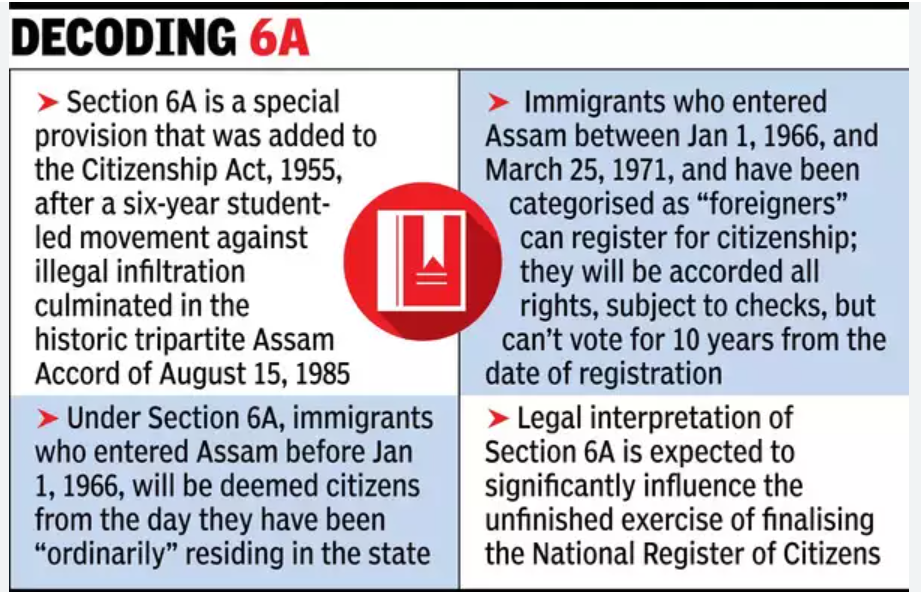23 October 2024 : Daily Current Affairs
1. On Section 6A of the Citizenship Act
- 1. On Section 6A of the Citizenship Act
- 2. UN Biodiversity Conference (COP16) Focuses on 30×30 Conservation Targets, Equitable Sharing of Genetic Resources, and Mobilizing $200 Billion for Global Biodiversity
- 3. Supreme Court Set to Rule on Constitutional Validity of Uttar Pradesh Madarsa Education Act Amid Broader Implications for Religious Education
- Prelims Facts
- 1. Three scientists discover new genus of jumping spiders ‘Tenkana’ in South India
- 2. India, Pakistan renew their agreement on Kartarpur Corridor
- 3. Brown dwarfs: wannabe stars
- 4. India Launches Mission Mausam to Enhance Weather Forecasting and Cloud Physics Research
- 5. Kazan: Russia’s Cultural Crossroads Hosts BRICS Summit Amid Shifting Demographic Dynamics
- 6. Towards more precise atomic clocks useful for navigation, Telecommunication & Aviation
(Source – The Hindu, International Edition – Page No. – 10)
| Topic: GS2 – Indian Polity |
| Context |
|
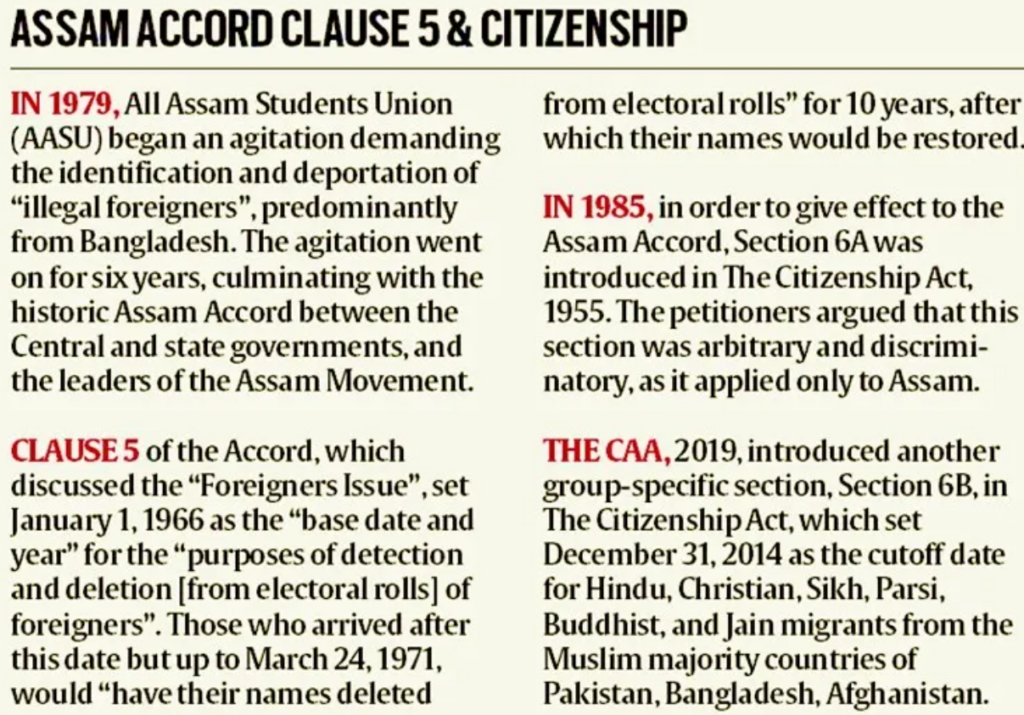
Why Was Section 6A Challenged?
- Petitioners argued that having a different cut-off date for Assam violated Article 14 (right to equality) and conflicted with Articles 6 and 7, which regulate citizenship for the rest of India.
- Concerns were raised about the demographic impact on Assam and the alleged threat to indigenous cultural and linguistic rights under Article 29 of the Constitution.
| What Does Section 6A Stipulate? |
|
|
Majority Ruling
- Justices Kant and Chandrachud upheld Section 6A, noting Assam’s unique historical and political context, balancing humanitarian concerns and the strain on Assam’s resources.
- They ruled that Section 6A is consistent with Articles 6 and 7, addressing migrants not covered by the Constitution’s citizenship provisions.
- The judges also clarified that “external aggression” in Article 355 refers to military threats, not migration driven by humanitarian reasons.
Dissenting Opinion
- The dissent argued that Section 6A had failed to control illegal migration and was now inconsistent with constitutional principles.
- The dissent noted that the provision lacked a sunset clause and incentivized illegal immigration.
- It criticised the identification process, relying solely on state intervention without provisions for self-declaration of foreign status.
Potential Ramifications
- The March 25, 1971, cut-off date underpins the National Register of Citizens (NRC), which identified 19 lakh residents in Assam as potential non-citizens.
- The ruling could bolster demands to repeal the Citizenship Amendment Act (CAA) of 2019, which has a different cut-off date for granting citizenship to non-Muslim migrants from neighbouring countries.
| Practice Question: Examine the constitutional and demographic implications of the Supreme Court’s decision to uphold Section 6A of the Citizenship Act, 1955, in the context of Assam’s migration issue. (150 Words /10 marks) |
2. UN Biodiversity Conference (COP16) Focuses on 30×30 Conservation Targets, Equitable Sharing of Genetic Resources, and Mobilizing $200 Billion for Global Biodiversity
(Source: Indian Express; Section: Explained; Page: 17)
|
Topic: GS3 – Environment |
|
Context: |
|
Analysis of News:
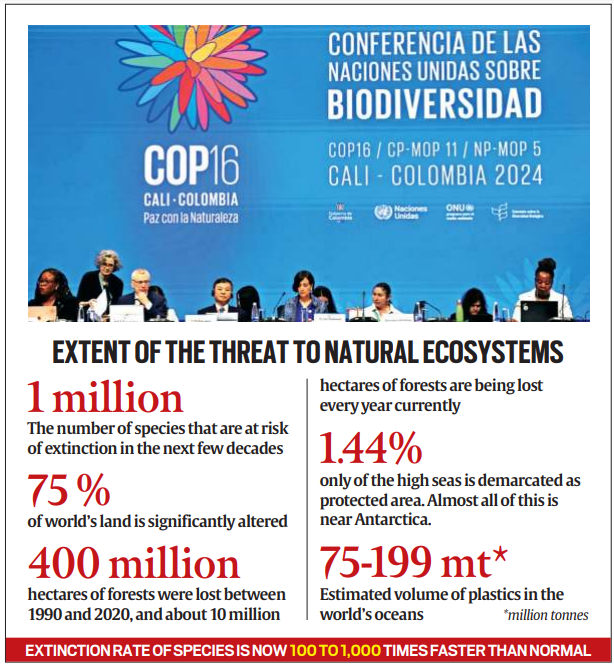
UN Biodiversity Conference and the Convention on Biological Diversity (CBD)
- Countries are currently meeting in Cali, Colombia, for the UN Biodiversity Conference, preceding the annual climate change summit in Baku, Azerbaijan.
- The CBD, established in 1992, aims to safeguard global biodiversity, restore ecosystems, and ensure equitable distribution of benefits from biological resources.
- This year’s COP16 meeting is significant as it follows the landmark Kunming-Montreal Global Biodiversity Framework finalized in 2022, which set out goals and targets for 2030.
What is the Kunming-Montreal Global Biodiversity Framework (KMGBF)?
- About: It is a multilateral treaty aimed at halting and reversing biodiversity loss globally by 2030.
-
- It was adopted in December 2022 during the 15th meeting of the Conference of the Parties (CoP).
-
- It supports the Sustainable Development Goals (SDGs) and builds upon the achievements and lessons learned from the Strategic Plan for Biodiversity 2011–2020.
- Purpose and Goals: It ensures that by 2030 at least 30% of areas of degraded terrestrial, inland water, and marine and coastal ecosystems are under effective restoration.
-
- It has 23 action-oriented global targets for urgent action over the decade to 2030 which will enable achievement towards the outcome-oriented goals for 2050.
-
- It is important to note that this target refers to collective global efforts rather than a requirement for each country to allocate 30% of its land and water areas.
- Long-Term Vision: The framework envisions that by 2050, there will be a collective commitment to living in harmony with nature, serving as a foundational guide for current actions and policies on biodiversity conservation and sustainable use.
30×30 Target and National Biodiversity Action Plans
- A key focus of COP16 is the 30×30 target, which aims to place 30% of the world’s lands and oceans under conservation by 2030 and restore 30% of degraded ecosystems.
- Countries are required to submit National Biodiversity Strategies and Action Plans (NBSAPs), similar to the climate change NDCs.
- As of now, only 32 countries have submitted their plans, with more expected to do so during the conference.
The High Seas Treaty and Genetic Resources
- The High Seas Treaty, concluded last year, was a major step in biodiversity conservation, aiming to protect marine biodiversity and regulate human activities in international waters.
- It also addresses the equitable sharing of benefits from genetic resources found in oceans, which is a major discussion point at COP16.
- The treaty seeks to ensure that profits from genetic sequences used for medical, commercial, or scientific purposes are shared equitably, especially with indigenous populations.
Financing for Biodiversity Conservation
- Finance remains a central issue at COP16, with a goal of mobilizing at least $200 billion annually by 2030 for biodiversity conservation.
- Developed countries are expected to contribute $20-30 billion yearly to support developing nations’ biodiversity efforts.
- Discussions also focus on phasing out harmful subsidies and incentives that damage biodiversity, such as those promoting deforestation or overfishing, with a target of redirecting $500 billion by 2030.
Potential New Financial Mechanisms
- Countries at COP16 are also exploring new financial mechanisms, including the possibility of setting up a dedicated biodiversity fund, biodiversity credits, and other innovative financing approaches, similar to carbon credits.
- These measures are essential for scaling up global biodiversity efforts and ensuring sustained financial support for conservation initiatives.
|
How India Can Achieve the New Biodiversity Goals? |
|
|
PYQ: With reference to ‘Global Environment Facility’, which of the following statements is/are correct? (a) It serves as financial mechanism for ‘Convention on Biological Diversity’ and ‘United Nations Framework Convention on Climate Change’ (b) It undertakes scientific research on environmental issues at global level (c) It is an agency under OECD to facilitate the transfer of technology and funds to underdeveloped countries with specific aim to protect their environment (d) Both (a) and (b) Ans: (a) |
|
Practice Question: The 16th Conference of Parties to the Convention on Biological Diversity (COP16) emphasizes the urgency of conserving biodiversity through the 30×30 target and equitable sharing of genetic resources. Discuss the significance of these goals and evaluate the challenges in mobilizing financial resources for global biodiversity conservation. (250 words/15 m) |
3. Supreme Court Set to Rule on Constitutional Validity of Uttar Pradesh Madarsa Education Act Amid Broader Implications for Religious Education
(Source: Indian Express; Section: Explained; Page: 17)
|
Context: |
|
Analysis of News:
Background of the Case
- The Supreme Court has reserved its verdict on a case challenging the Allahabad High Court’s decision to strike down the Uttar Pradesh Board of Madarsa Education Act, 2004.
- The Act provides a legal framework for madarsa education in Uttar Pradesh, combining religious and secular curricula.
- The High Court ruled the Act unconstitutional for violating secularism, the Right to Education, and conflicting with central laws.
What is the Uttar Pradesh Board of Madarsa Education Act, 2004?
Overview of the Act:
- The Act aimed to regulate and govern the functioning of madrasas (Islamic educational institutions) in the state of Uttar Pradesh.
- It provided a framework for the establishment, recognition, curriculum, and administration of madrasas across Uttar Pradesh.
- Under this Act, the Uttar Pradesh Board of Madarsa Educationwas established to oversee and supervise the activities of madrasas in the state.
Allahabad High Court Ruling
- Secularism: The HC ruled that compulsory Islamic education in madarsas contradicts the state’s duty to provide equal, secular education without favoring any religion.
- Right to Education: The HC stated that the government failed to provide quality secular education in madarsas, violating Article 21A of the Constitution.
- Conflict with UGC Act: The court found that the Madarsa Board granting degrees conflicted with the UGC Act, as only universities can confer degrees.
Key Arguments in the Supreme Court
- Religious Education vs. Religious Instruction: The court examined whether madarsas provide religious education (allowed) or religious instruction (prohibited in state-recognized institutions).
- Striking Down the Entire Act: The SC is considering whether the HC was justified in striking down the entire Act or if amendments could ensure secular education while preserving the religious component.
Potential Impact of the Verdict
- The decision will impact madarsa education in Uttar Pradesh but could have broader implications for religious educational institutions nationwide, including gurukuls and convent schools, as it will define how secularism interacts with religious education across the country.
|
What are the Constitutional Provisions Regarding Education in India? |
|
|
|
PYQ: Which of the following provisions of the Constitution does India have a bearing on Education? (2012) 1) Directive Principles of State Policy 2) Rural and Urban Local Bodies 3) Fifth Schedule 4) Sixth Schedule 5) Seventh Schedule Select the correct answer using the codes given below: (a) 1 and 2 only (b) 3, 4 and 5 only (c) 1, 2 and 5 only (d) 1, 2, 3, 4 and 5 Ans- (d) |
|
Practice Question: Analyze the implications of the Supreme Court’s decision on the Uttar Pradesh Madarsa Education Act, particularly in relation to secularism, the Right to Education, and the future of religious education in India. (250 words) (250 words/15 m) |
Prelims Facts
1. Three scientists discover new genus of jumping spiders ‘Tenkana’ in South India
(Source – The Hindu, International Edition – Page No. – 3)
| Context |
| A new genus of jumping spiders, named ‘Tenkana’, has been discovered across southern India.It includes two previously known species and a newly discovered one called Tenkana jayamangali from Karnataka. |
Analysis of the news:
- A new genus of jumping spiders called ‘Tenkana’ has been discovered across southern India, with species found in Tamil Nadu, Puducherry, Karnataka, Telangana, and Andhra Pradesh.
- The genus includes two previously known species and a newly introduced one, Tenkana jayamangali, from Karnataka.
- The name ‘Tenkana’ is derived from the Kannada word for south, as the species are found in southern India and northern Sri Lanka.
- The research was conducted by a team of scientists from institutions in India and Canada, with their findings published in the journal Zookeys.
- Both genetic studies and physical examinations were used to identify the new genus.
- Tenkana spiders prefer drier, ground habitats, unlike related species that inhabit forests.
- Two previously known species, Tenkana manu and Tenkana arkavathi, have been reassigned to the new genus.

2. India, Pakistan renew their agreement on Kartarpur Corridor
(Source – The Hindu, International Edition – Page No. – 4)
| Context |
|
More About Kartarpur Corridor:
- The Kartarpur Corridor is a travel route connecting India and Pakistan, facilitating Indian pilgrims to visit Gurdwara Darbar Sahib Kartarpur in Pakistan, a significant Sikh religious site.
- An agreement was initially signed on October 24, 2019, to allow this corridor’s operation, valid for five years.
- The agreement has been renewed for another five years, extending its validity until 2029, ensuring uninterrupted access for pilgrims.
- The corridor allows approximately 5,000 pilgrims daily, but current daily numbers have decreased to only a few hundred.
- Pilgrims are required to pay a service fee of $20 (around ₹1,680), which India has requested Pakistan to waive.
- Pakistan claims the fee is necessary to cover the $17 million spent on refurbishing the gurdwara.
- The corridor represents a significant step in facilitating religious tourism and enhancing cultural ties between the two nations.
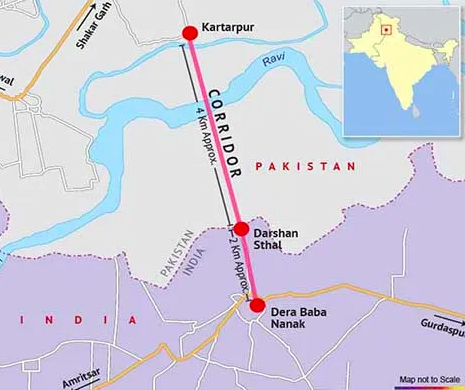
3. Brown dwarfs: wannabe stars
(Source – The Hindu, International Edition – Page No. – 7)
| Context |
|
What Are Brown dwarfs?
- Brown dwarfs are objects that are too big to be planets but too small to be stars.
- They lack enough mass to ignite nuclear fusion like stars but are more massive than the largest planets.
- Brown dwarfs can burn a heavy form of hydrogen called deuterium but not regular hydrogen like stars.
- The first brown dwarf, Gliese 229B, was discovered in 1995.
- Recently, researchers found that there are actually two brown dwarfs, Gliese 229Ba and Gliese 229Bb, in a rare binary system.
- These two brown dwarfs are gravitationally locked and orbit each other, while also orbiting a small star.
- Gliese 229Ba and Gliese 229Bb have masses 38 and 34 times greater than Jupiter, respectively.
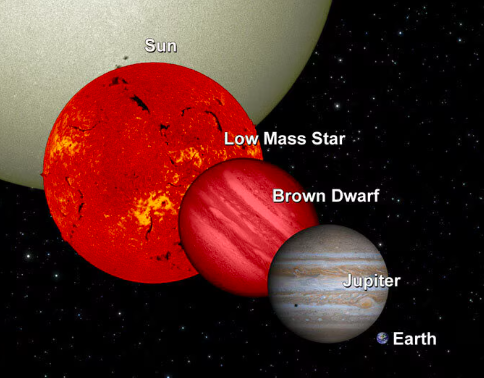
4. India Launches Mission Mausam to Enhance Weather Forecasting and Cloud Physics Research
(Source: Indian Express; Section: Explained; Page: 17)
| Context: |
| This article talks about Mission Mausam which was recently launched by the Indian Government. |
Analysis of News:
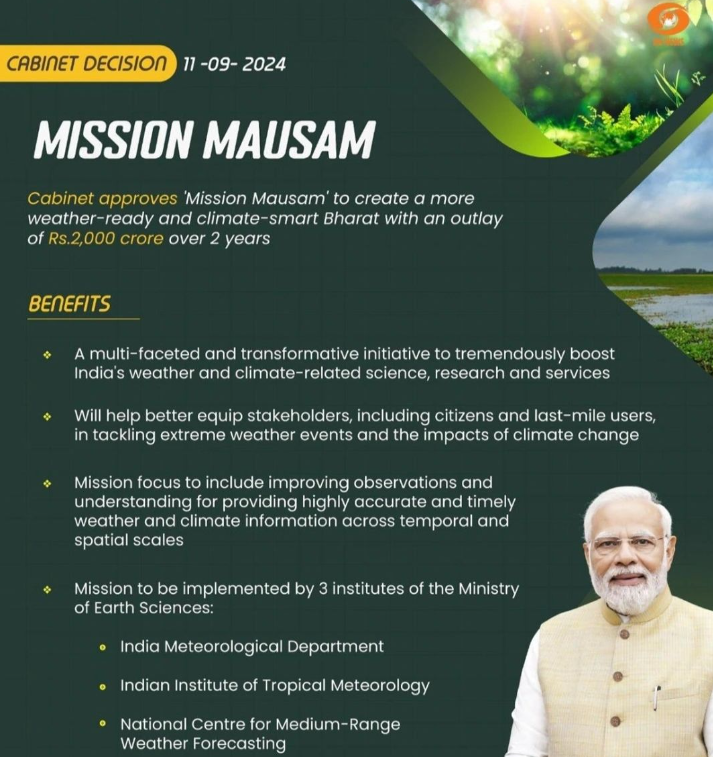
Mission Mausam Overview
- Mission Mausam, launched recently by the Indian government, aims to enhance weather forecasting capabilities and manage specific weather phenomena such as rainfall, hail, and fog.
- It seeks to improve cloud physics research, a crucial aspect for effective weather management.
Cloud Chamber Establishment
- A key element of this initiative is the establishment of a first-of-its-kind cloud chamber at the Indian Institute of Tropical Meteorology (IITM), Pune. This chamber will allow for in-depth research on cloud physics, particularly focusing on monsoon clouds.
What is a Cloud Chamber?
- A cloud chamber is a closed cylindrical or tubular device where water vapor, aerosols, and other elements are introduced.
- Under controlled humidity and temperature, clouds form inside the chamber, enabling scientists to study cloud droplets, ice particles, and seed particles.
- Unlike basic cloud chambers in other countries, India’s cloud chamber will feature convection properties, essential for studying Indian monsoon clouds.
Importance of Cloud Physics
- Cloud physics involves understanding cloud behavior under normal and extreme conditions, studying intra-particle interactions, and analyzing the formation of rain droplets and ice particles.
- The knowledge gained from studying cloud physics will be critical for planning weather modification strategies.
Application of the Cloud Chamber
- Scientists will use the cloud chamber to customize physical and atmospheric parameters, closely simulating Indian weather and climate conditions.
- This controlled environment will help in understanding monsoon cloud behavior.
- Over the next 18-24 months, advanced instrumentation will be developed to monitor and probe these conditions.
Weather Modification Techniques
- India has experimented with cloud seeding under the Cloud Aerosol Interaction and Precipitation Enhancement Experiment (CAIPEEX) program.
- Trials in Maharashtra’s Solapur district showed that cloud seeding could enhance rainfall by up to 46%, although it is not a guaranteed solution for addressing rainfall shortages.
5. Kazan: Russia’s Cultural Crossroads Hosts BRICS Summit Amid Shifting Demographic Dynamics
(Source: Indian Express; Section: Explained; Page: 17)
| Context: |
|
Analysis of News:
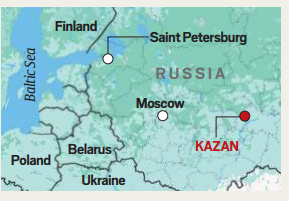
Importance of Kazan
- Kazan is Russia’s third-largest city and a center for petrochemicals, military industries, and technology.
- Located in the Republic of Tatarstan, it embodies Russia’s evolving demographic identity, balancing between European and Asian influences.
- The city is home to both ethnic Russians and Tatars, making it a symbol of Russia’s multicultural future.
Russia’s Changing Demographics
- Russia is a vast, multi-ethnic country with over 80% of its population being ethnic Russians. However, this demographic is shrinking due to lower birth rates (1.3 children per woman) among ethnic Russians compared to Muslim ethnic minorities (2.3 children per woman).
- Muslim ethnicities, especially Turkic and Asiatic groups, are expected to increase their share of the population from 10% to triple that in coming decades.
- Migration is also expected to rise, further diversifying Russia’s population.
Kazan: A Symbol of Diversity
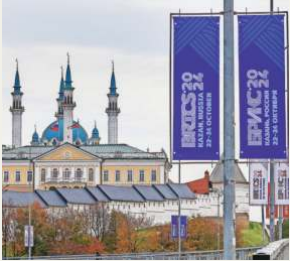
- Kazan’s population is almost equally divided between ethnic Russians (48.6%) and Tatars (47.6%).
- The city’s cultural landmarks, including the Orthodox Annunciation Cathedral and the Kul Sharif Mosque, highlight its unique blend of Christian and Muslim heritage.
- The rebuilt Kul Sharif Mosque, originally destroyed by Ivan the Terrible, symbolizes reconciliation and cooperation among different religious communities.
6. Towards more precise atomic clocks useful for navigation, Telecommunication & Aviation
(Source – https://pib.gov.in/PressReleseDetail.aspx?PRID=2067034®=3&lang=1 )
| Context |
|
About The Research:
- Rydberg atoms are highly excited atoms, and their response is measured using Electromagnetically Induced Transparency (EIT), which makes an opaque medium transparent.
- The team also leveraged the Doppler effect to enhance the response to magnetic fields by ten times, using thermal rubidium atoms at room temperature.
- Doppler effect occurs when atoms move towards or away from the laser, causing a shift in frequency, which the researchers used to their advantage for more precise measurements.
- This method does not require cooling of atoms or ultra-high vacuum conditions, making it simpler and more practical for applications.
- The enhanced quantum magnetometry can be used in fields like geophysics, brain activity detection, space exploration, and archaeology.
- The work demonstrates the effectiveness of room-temperature setups for detecting weak magnetic fields and has been published in the New Journal of Physics.

